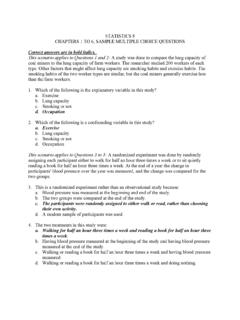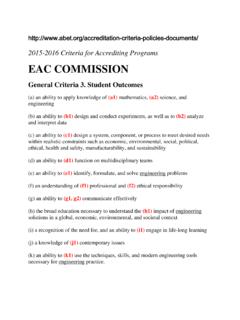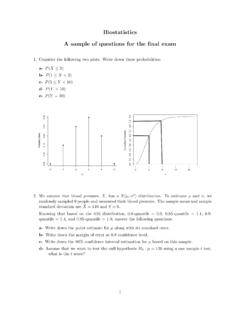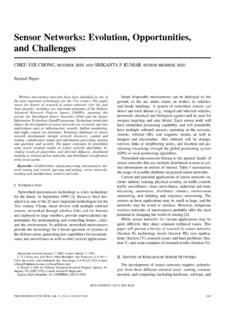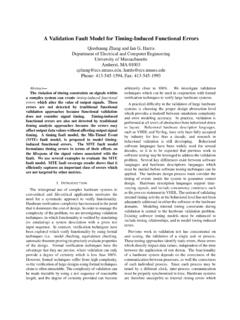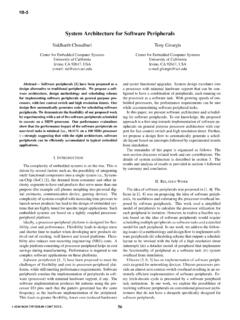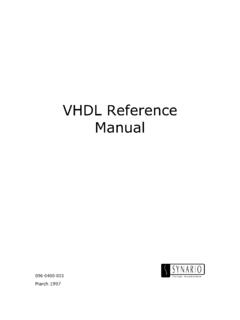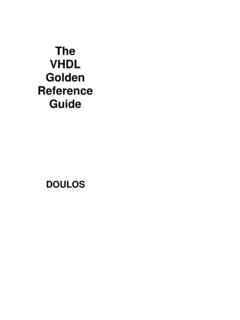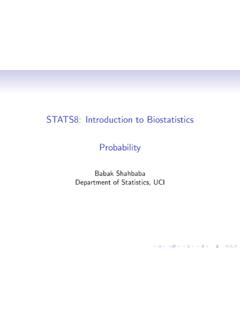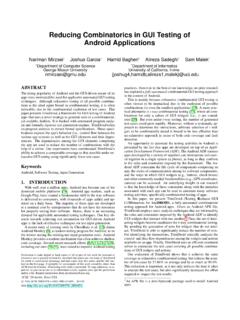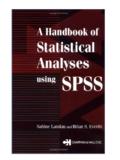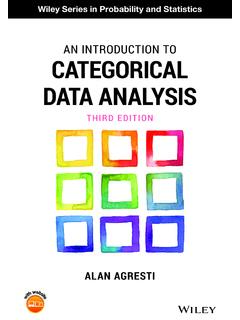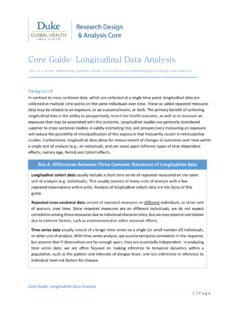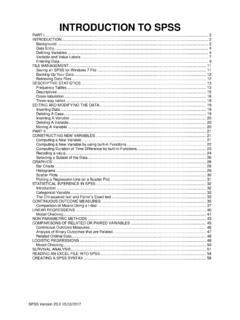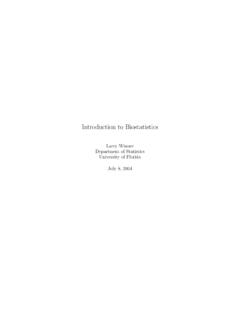Transcription of Results from the 2017 AP Statistics Exam
1 Results from the 2017 AP Statistics ExamJessica Utts, University of California, IrvineChief Reader, AP 28, 2017 State question Present solution Describe common student errors Suggest teaching tips Report average score (all at the end)Plan for each of the six questionsQuestion #1: Regression for length and weight of gray wolvesExplain positive, linear, strong; interpret slope; find weight given length & residualResearchers studying a pack of gray wolves in North America collected data on the length x, in meters, from nose to tip of tail, and weight y, in kilograms, of the wolves. A scatterplotof weight versus length revealed a relationship between the two variables described as positive, linear, and 1a)For the situation described above, explain what is meant by each of the following :Question 1 Part (a)Solution Part (a):In the context of a scatter plot of y = weight and x = length:A positiverelationship means that wolves with higher values of length also tend to have higher linearrelationship means that when length increases by one meter, weight tends to change by a constant amount, on strongrelationship means that the data points fall close to a line (or curve).
2 Defining a positiverelationship by simply saying that there is a positive correlation. Using correlation to define a linearrelationship. A correlation coefficient is a measure of the strength of a linear relationship, but it does not by itself explain the meaning of a linear relationship. It is more appropriate to use correlation to discuss a strong relationship. Indicating that a relationship is strongwhen points in the scatterplot are close together or not too scattered. The response should indicate that a relationship is strong when the points in the scatterplot are close to a line, or more generally, a Student Errors, Q1(a)The data collected from the wolves were used to create the least-squares equation = + )Interpret the meaning of the slope of the least-squares regression line in contextQuestion 1 Part (b)Solution Part (b):The slope of indicates that two wolves that differ by one meter in length are predicted to differ by kilograms in weight, with the longer wolf having the higher weight.
3 Implying that the slope of a least squares regression line corresponds to an exactrelationship between changes in observed values of y as x changes. Failure to link the increase in the predicted response to an increase of a specific size in the explanatory variable. For instance, an unacceptable response is For any change in length, the predicted weight increases by kg. 10 Common Student Errors, Q1(b)[The data collected from the wolves were used to create the least-squares equation = + ]c)One wolf in the pack with a length of meters had a residual of kilograms. What was the weight of the wolf?Question 1 Part (c)Solution Part (c):In general, residual = actual weight predicted weight, or equivalently, actual weight = predicted weight + residual. In this situation:Predicted weight = 16. 46 + ( ) = kgActual weight = predicted weight + residual So y = = kilograms.
4 In calculating the actual weight from the regression equation for a specific x when a residual is given, many responses stopped after computing the predicted value. They most likely forgot the question! Some responses incorrectly replaced the residual with the intercept in the calculation of the actual weight, or the intercept with the residual in the calculation of the predicted Student Errors, Q1(c)Q1 Teaching tips -Encourage students to: Read the problem Use better handwriting Focus on the question, keep thoughts clear and concise Use graphs for clarification (in part a), but include words Complete calculations follow problem to the end with work Avoid sloppy terminology ( the scatterplot is straight vs. the points on the ) Distinguish between statistical use of words like correlation and ordinary English use. For example, r close to 1 or correlation coefficient clearly indicate statistical Teaching tips, continued Things to reinforce Don t use deterministic wording in slope interpretation (include predicted or estimated ) Slope is for a 1 unit change in x, not just a change Strength is a measure of how closely the data follow a pattern (line or curve), not how close the points are to each other Small residuals can be an indication of the strength of the model Use backwards questions in class Write the regression equation associated with the following Explain what is meant when you have high #2: Asking for a water cup but filling it with sodaConstruct and interpret a confidence interval for a proportion.
5 Use it to get a confidence interval for the cost to the restaurantQuestion 2 Part (a):The manager of a local fast-food restaurant is concerned about customers who ask for a water cup when placing an order but fill the cup with a soft drink from the beverage fountain instead of filling the cup with water. The manager selected a random sample of 80 customers who asked for a water cup when placing an order and found that 23 of those customers filled the cup with a soft drink from the beverage fountain.(a) Construct and interpret a 95 percent confidence interval for the proportion of all customers who, having asked for a water cup when placing an order, will fill the cup with a soft drink from the beverage Part (a) (Step 1 of 3):Step 1: Identify the appropriate confidence interval by name or formula and check appropriate conditions. The appropriate procedure is a one-sample z-interval for a population proportion p.
6 In this case, the population is all customers of this restaurant who ask for a water cup, and pis the proportion of that population that will fill the cup with a soft drink. The appropriate formula is (1 ) Solution Part (a) (Step 1 of 3, continued):Step 1:Conditions: sample (number of successes 10and number of failures (1 ) 10)For condition 1, the stem of the problem states that a random sample of customers who asked for a water cup was used. For condition 2, the number of successes (filled cup with soft drink) is 23 and the number of failures is 57, both of which are greater than Part (a) (Step 2 of 3):Step 2: Correct mechanicsThe sample proportion is =2380= 0. confidence interval is:= ( )= to 1. (1 )80 Solution Part (a) (Step 3 of 3):Step 3: InterpretationWe can be 95% confident that in the population of all customers at this fast-food restaurant who ask for a water cup, the proportion that will fill it with a soft drink is between and Common Student Errors, Q2(a) Identification of procedure missing or incorrect Not checking conditions Omitting the large sample condition or verifying only one of the two inequalities Mislabeling conditions, Independence for the sample size condition Vague reference to a normal distribution Stating that the sample or population has a normal distribution (for a categorical variable) Inappropriate large sample condition.
7 N 30 Using incorrect critical value (wrong z* or a t*) or using t and showing df Using an incorrect formula for the standard error of a sample proportionCommon Student Errors, Q2(a), continued Supporting work that doesn t match the confidence interval given Using incorrect or nonstandard notation without defining it Calculating an unreasonable interval for a proportion not realizing that a proportion must be between 0 and 1 Not recognizing that the population of interest is all customers who ask for a water cup at this fast-food restaurant Interpreting confidence level instead of confidence interval, or attempting to blend the interpretation of the interval with the interpretation of the confidence level in a single sentence, or providing interpretations of both confidence interval and confidence level Saying mean in the interpretation of the intervalQuestion 2 Part (b).
8 (b) The manager estimates that each customer who asks for a water cup but fills it with a soft drink costs the restaurant $ Suppose that in the month of June 3000 customers ask for a water cup when placing an order. Use the confidence interval constructed in part (a) to give an interval estimate for the cost to the restaurant for the month of June from the customers who ask for a water cup but fill the cup with a soft Part (b):Using the confidence interval in Part (a), a 95% interval estimate for the number of customers in June who ask for a water cup but then filled it with a soft drink is 3000 to 3000 , or 565 to 1160. At a cost of $ per customer, a 95% interval estimate for the cost to the restaurant in June is $ to $ Student Errors, Q2(b) Calculating a single value (point estimate) in part (b) rather than an interval Not using the interval from part (a) as directed Not showing work in part (b)Q2 Teaching tips In inference questions, ask students to identify the population and parameter of interest.
9 Encourage students to use the language in the stem of the question when defining the parameter. Discuss whyeach condition is being checked for an inference procedure as well as how to check the condition. Use applets and hands-on activities to demonstrate what happens when each condition isn t met. Insist on proper notation throughout the course refer students to the formula sheetQ2 Teaching tips, continued Emphasize the difference between interpreting a confidence intervaland a confidence level. Use hands-on activities and applets involving repeated sampling to illustrate the idea of a confidence level interpretation. Give students ample practice in distinguishing categorical variables/ data (proportions) from quantitative variables/ data (means). Have students make a summary chart of inference procedures with the appropriate names, conditions, and formulas for #3: Melons from organic and nonorganic farmsCalculate a normal probability, a weighted probability and a conditional probabilityQuestion 3A grocery store purchases melons from two distributors, J and K.
10 Distributor J provides melons from organic farms. The distribution of the diameters of the melons from Distributor J is approximately normal with mean 133 millimeters (mm) and standard deviation 5 mm.(a)For a melon selected at random from Distributor J, what is the probability that the melon will have a diameter greater than 137 mm?Solution Part (a)Let Xdenote the diameter of a randomly selected melon from Distributor J. Xhas an approximately normal distribution with mean 133 mm and standard deviation 5 z-score for a diameter of 137 mm is Therefore -=== () () > = >= = Thinking that a normal probability problem can be solved using the t-distribution Thinking that a normal probability problem always involves using x-bar. Thinking that normalcdf(137, 1000000, 133, 5) shows work; identifies parameters and boundary conditions.
